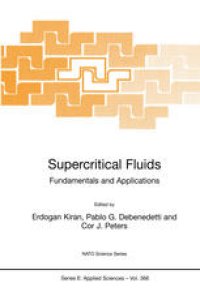
Ebook: Supercritical Fluids: Fundamentals and Applications
- Tags: Industrial Chemistry/Chemical Engineering, Physical Chemistry, Polymer Sciences, Physics general
- Series: NATO Science Series 366
- Year: 2000
- Publisher: Springer Netherlands
- Edition: 1
- Language: English
- pdf
Supercritical fluids are neither gas nor liquid, but can be compressed gradually from low to high density and they are therefore interesting and important as tunable solvents and reaction media in the chemical process industry. By adjusting the density the properties of these fluids can be customised and manipulated for a given process - physical or chemical transformation. Separation and processing using supercritical solvents such as CO2 are currently on-line commercially in the food, essential oils and polymer industries. Many agencies and industries are considering the use of supercritical water for waste remediation. Supercritical fluid chromatography represents another, major analytical application. Significant advances have recently been made in materials processing, ranging from particle formation to the creation of porous materials.
The chapters in this book provide tutorial accounts of topical areas centred around: (1) phase equilibria, thermodynamics and equations of state; (2) critical behaviour, crossover effects; (3) transport and interfacial properties; (4) molecular modelling, computer simulation; (5) reactions, spectroscopy; (6) phase separation kinetics; (7) extractions; (8) applications to polymers, pharmaceuticals, natural materials and chromatography; (9) process scale-up.
Supercritical fluids are neither gas nor liquid, but can be compressed gradually from low to high density and they are therefore interesting and important as tunable solvents and reaction media in the chemical process industry. By adjusting the density the properties of these fluids can be customised and manipulated for a given process - physical or chemical transformation. Separation and processing using supercritical solvents such as CO2 are currently on-line commercially in the food, essential oils and polymer industries. Many agencies and industries are considering the use of supercritical water for waste remediation. Supercritical fluid chromatography represents another, major analytical application. Significant advances have recently been made in materials processing, ranging from particle formation to the creation of porous materials.
The chapters in this book provide tutorial accounts of topical areas centred around: (1) phase equilibria, thermodynamics and equations of state; (2) critical behaviour, crossover effects; (3) transport and interfacial properties; (4) molecular modelling, computer simulation; (5) reactions, spectroscopy; (6) phase separation kinetics; (7) extractions; (8) applications to polymers, pharmaceuticals, natural materials and chromatography; (9) process scale-up.
Supercritical fluids are neither gas nor liquid, but can be compressed gradually from low to high density and they are therefore interesting and important as tunable solvents and reaction media in the chemical process industry. By adjusting the density the properties of these fluids can be customised and manipulated for a given process - physical or chemical transformation. Separation and processing using supercritical solvents such as CO2 are currently on-line commercially in the food, essential oils and polymer industries. Many agencies and industries are considering the use of supercritical water for waste remediation. Supercritical fluid chromatography represents another, major analytical application. Significant advances have recently been made in materials processing, ranging from particle formation to the creation of porous materials.
The chapters in this book provide tutorial accounts of topical areas centred around: (1) phase equilibria, thermodynamics and equations of state; (2) critical behaviour, crossover effects; (3) transport and interfacial properties; (4) molecular modelling, computer simulation; (5) reactions, spectroscopy; (6) phase separation kinetics; (7) extractions; (8) applications to polymers, pharmaceuticals, natural materials and chromatography; (9) process scale-up.
Content:
Front Matter....Pages i-xvi
Supercritical Fluids: Their Properties and Applications....Pages 1-29
Physico-Chemical Principles of Supercritical Fluid Science....Pages 31-68
Phase Equilibria in Near-Critical Solutions: Binary and Ternary Mixtures of Carbon Dioxide and Certain Solutes and the Occurrence of Two-Phase Holes....Pages 69-87
Critical and Crossover Phenomena in Fluids and Fluid Mixtures....Pages 89-121
Phase Separation By Nucleation and Ly Spinodal Decomposition: Fundamentals....Pages 123-166
Polymer Miscibility and Kinetics of Pressure — Induced Phase Separation in Near-Critical and Supercritical Fluids....Pages 167-192
Fundamentals of Interfacial Properties....Pages 193-209
Theory and Simulation of Colloid and Interface Science in Supercritical Fluids....Pages 211-227
Polymer Phase Behavior: Todays Achievements and Tomorrows Needs....Pages 229-252
Polymerization and Polymer Modification Reactions in Near and Supercritical Fluids....Pages 253-276
Applications of Supercritical Fluids to Pharmaceuticals: Controlled Drug Release Systems....Pages 277-289
Supercritical Water and Other Fluids — A Historical Perspective....Pages 291-306
Solution Chemistry in Supercritical Water: Spectroscopy and Simulation....Pages 307-322
Molecular Simulation and Modeling of Supercritical Water and Aqueous Solutions....Pages 323-343
Solute Reaction Dynamics in the Compressible Regime....Pages 345-394
Destruction of Toxic Organic Materials Using Super-Critical Water Oxidation: Current State of the Technology....Pages 395-424
Kinetic Studies of Methanol Oxidation in Supercritical Water and Carbon Dioxide....Pages 425-437
Sub- and Supercritical Fluid Processing of Agrimaterials: Extraction, Fractionation and Reaction Modes....Pages 439-450
Modeling of Natural Materials Extraction....Pages 451-488
Design Procedures and Scale-Up for Separation Processes with Supercritical Fluids....Pages 489-498
Back Matter....Pages 499-516
....Pages 517-558